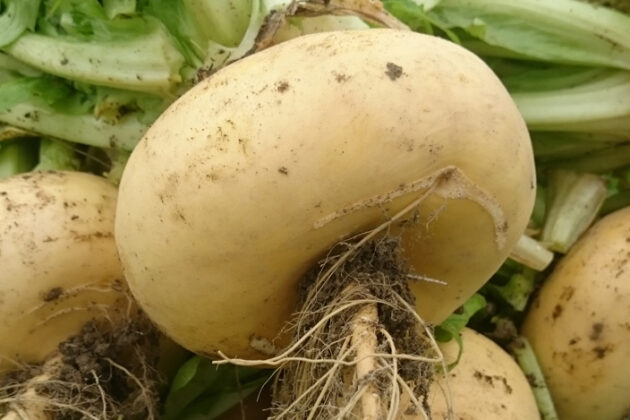A great future for Arctic food

It seems like pure, natural Arctic food is going to have a great future on the world market. And its Arctic origin is precisely what gives it a major competitive advantage.
People are concerned about where their food comes from, how it is produced, whether it is sustainable and of course, if it tastes good.
Many research studies show that people are most positive about food from their own country and their own region. Building brands is expensive and time consuming, and in many cases one notices that the region in which a type of food comes from is used in branding. This can also be done regarding food from the Arctic.
Value and challenges
For example, research shows that some vegetables and berries produced in the North have a better appearance, better nutritional content, are often sweeter in taste, and also have a more crisp and juicier consistency compared to vegetables and berries grown in warmer climates.
“It is an established “truth” that ham from Parma is best, wine from Bordeaux is luxurious and Champagne is the finest sparkling drink. If this type of marketing is to be successful, it is important that people believe that the food fits with the region in question. Therefore, Arctic clementines probably won’t be much of a success, while Målselv turnips are an example of a successful combination of product and geography”, says Nofima scientist Bjørg Helen Nøstvold.
Nofima’s scientists, in collaboration with Nibio, have assessed the status, value and challenges of food production in Arctic Norway in the “Arctic as a Food Producing Region” project, which is part of a large international project endorsed by The Arctic Council.
The project’s results indicate great potential for both agricultural and seafood products from the Arctic.

“The aim of the “Arctic food” project has been to assess the potential for increased production and value creation of food produced in the Arctic areas of Norway. The overall goal is to contribute to economic development in Arctic communities”, says Nofima scientist Ingrid Kvalvik, who has led the research work.
Public support is important during the start-up phase
The report shows that in order to increase the production of food in the Arctic, public support schemes such as Innovation Norway and the SkatteFUNN Tax Incentive Scheme are important.
“These have been crucial to many small companies during their start-up phase. At the same time, there are clear signals that getting to know and taking advantage of the various support schemes uses up a lot of the companies’ time and resources. The start-up phase is critical for small-scale food producers, both economically and in dealing with taxation and reporting systems”, says Ingrid Kvalvik.
Higher VAT and tax registration thresholds, a taxation system that is scaled in relation to turnover, and more training and assistance from the Norwegian Food Safety Authority can all help more companies to survive. This is the feedback that scientists have received from the producers they have talked to.
“It is also possible that an increased effort by Innovation Norway regarding established small companies may help even more companies expand their production and markets, both nationally and internationally. Therefore, local food production will be even more important for the regions in a socio-economic perspective”, says the project manager.
The project also found that food-producing companies in the Arctic have the potential to improve in terms of user-friendliness and long-term thinking.
“In order to increase production, one must develop profitable market channels in parallel with good marketing strategies for Arctic food”, says Bjørg Helen Nøstvold.
Fresh and tasty
The findings show that the food products have the potential of achieving increased value precisely because of their Arctic origin.
“Surveys among Norwegian, Swedish and British consumers show that Arctic food is associated with positive characteristics such as being fresh and tasty, and that many of the characteristics associated with Arctic food are factors that are common in modern international food trends, such as health, natural, genuine and traditional”, says Ingrid Kvalvik.

One marketing opportunity that can be investigated further is to place emphasis on sensory characteristics in Arctic food, such as smell, taste and texture.
“Research shows that some vegetables and berries produced in the North have a better appearance, better nutritional content, are often sweeter in taste, and also have a more crisp and juicier consistency compared to vegetables and berries grown in warmer climates. Potentially, this could be exploited in marketing work involving vegetables, berries and other products with unique characteristics from the Arctic”, says Nøstvold.
Climate change presents challenges – and opportunities
Climate change can present a number of challenges in relation to food production in the Arctic. This is especially the case regarding the increased risk of winter damage, new and more diseases, and more precipitation that can pose challenges during harvest times. This will require new operating systems and new technological solutions.
However, climate change may also mean that countries in the North must contribute to increased global food production to a greater extent. Production in the North is important and there seems to be an increasing demand for more food and the pure, safe, tasty, sustainable food that is produced in the Arctic.
“In 30 years time, the situation could look quite different. There is the possibility that agricultural products from Northern Norway will be in demand further south and internationally. Therefore, it is important that we start laying the foundations for such an eventuality right now, and build knowledge, infrastructure and safeguard agricultural areas in the region. In addition, seafood production may become increasingly important. However, growth in fish farming and agricultural production is heavily dependent on political framework conditions”, states the report.
Facts about the “Arctic Food“ project
- The aim of the “Arctic Food” project has been to assess the potential for increased production and value creation of food produced in the Arctic areas of Norway.
- Sustainable food production is an important international goal for the future, and the project has investigated the possibilities for increased production and value creation of Arctic food.
- The report is part of a larger project that is incorporated into the Arctic Council’s project portfolio and endorsed by the Sustainable Development Working Group (SDWG). Other participants include Canada, Denmark, Greenland, Iceland, Norway and Russia.
- The report has been compiled by Nofima in collaboration with Nibio and is funded by the Ministry of Foreign Affairs.
